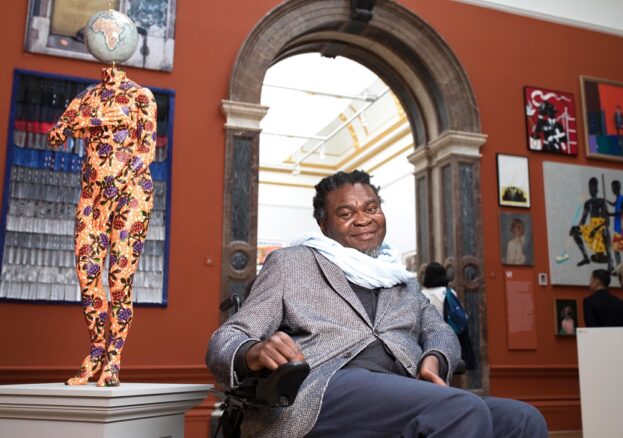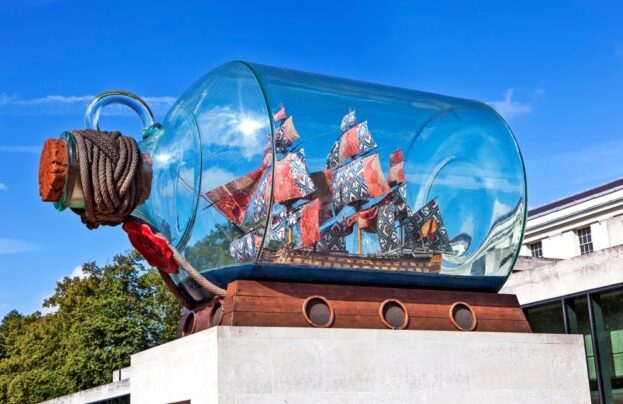
Yinka Shonibare is a visual artist who has gained international recognition for his vibrant and thought-provoking works of art. Born in London in 1962, Shonibare spent much of his childhood in Nigeria before returning to Britain to study at Goldsmiths College and the Royal College of Art. He works in sculpture, photography, and film, and is known for his use of African wax prints, which he incorporates into his pieces as a way of exploring themes of cultural identity, globalization, and colonialism.
One of Shonibare’s most famous works is “Nelson’s Ship in a Bottle,” a large-scale sculpture that was installed on the Fourth Plinth in Trafalgar Square in 2010. The sculpture consists of a replica of Horatio Nelson’s flagship, the HMS Victory, contained within a giant glass bottle. The sails of the ship are made from brightly coloured African wax prints, while the ship itself is made from fiberglass. The piece is a commentary on Britain’s imperial past and its relationship with Africa, as well as a celebration of the diversity and complexity of contemporary British culture.

Shonibare’s use of African wax prints is a recurring motif in much of his work. The prints were originally produced in the Netherlands in the 19th century and were sold to West African markets, where they became popular as a symbol of cultural identity and pride. Today, the prints are widely used across the African diaspora, and Shonibare incorporates them into his pieces as a way of exploring the complex interplay between cultures and histories.
Another powerful piece by Shonibare is “The Swing (After Fragonard),” a sculpture that reimagines Jean-Honoré Fragonard’s famous painting “The Swing” in a contemporary context. The sculpture features a life-size figure dressed in a Victorian-style gown made from African wax prints, suspended from a rope swing. The piece is a commentary on the history of colonialism and the ongoing impact of Western cultural influences on African societies.
In addition to his sculptures, Shonibare also works in photography and film. His film “Un Ballo in Maschera (A Masked Ball),” which was commissioned by the Royal Opera House in London, is a reimagining of Verdi’s opera of the same name, set in a contemporary African context. The film features an all-Black cast dressed in colourful African wax prints, and explores themes of power, identity, and colonialism.
Shonibare’s work has been exhibited widely in galleries and museums around the world, and has received numerous awards and honours. In 2004, he was nominated for the Turner Prize, and in 2005, he was awarded the title of Member of the Most Excellent Order of the British Empire (MBE). He has also been awarded the Decoration for Services to the Arts by the Nigerian government, and was elected as a Royal Academician in 2013.
Since being elected as a Royal Academician in 2013, Shonibare has continued to produce significant works of art that challenge established historical narratives and celebrate cultural diversity. One of his recent installations, “The British Library,” was commissioned by the House of St. Barnabas, a social enterprise in London that works to support people affected by homelessness. The installation features a collection of 6,000 books bound in African wax-printed cotton, with titles chosen by members of the public to reflect their experiences and perspectives. The installation was intended as a tribute to the power of literature to bring people together and foster understanding across cultures.
Another major work by Shonibare is “Wind Sculpture (SG) I,” a large-scale sculpture commissioned for the Doris C. Freedman Plaza in New York City in 2018. The sculpture features a vibrant, spiraling form made from fiberglass and Dutch wax-printed cotton, and stands over 20 feet tall. The sculpture was intended as a celebration of diversity and cultural exchange, and its dynamic form and use of bold colours make it a striking addition to the urban landscape.
Shonibare has also continued to work in film, with his recent project “Addio del Passato” (2019) premiering at the Venice Biennale. The film, which takes its title from a famous aria in Verdi’s opera “La Traviata,” explores themes of memory and loss, with a focus on the experiences of refugees and migrants. The film was shot in the Italian city of Palermo, and features a diverse cast of performers, all dressed in African wax-printed fabrics.
Yinka Shonibare is a wheelchair user, having been diagnosed with transverse myelitis, a condition that affects the spinal cord, in 1995. Despite the challenges he has faced as a disabled artist, he has continued to create powerful and thought-provoking works of art that explore themes of cultural identity, globalization, and colonialism.
Shonibare’s experiences as a disabled artist have also influenced his advocacy work for accessibility and inclusion in the arts. He has been vocal about the need for greater representation of disabled artists and audiences and has collaborated with disability-led organisations to promote awareness and understanding of disability issues. In 2018, he participated in a panel discussion on disability and the arts at the Tate Modern in London, where he discussed his own experiences as a disabled artist and the need for greater accessibility in cultural institutions.
Shonibare’s work as a disabled artist is a testament to the power of creativity and resilience in the face of adversity. Through his art and advocacy, he has challenged traditional narratives and celebrated the diversity of human experience, while also calling for greater accessibility and inclusion in the arts.
In addition to his artistic practice, Shonibare is also an active participant in cultural and social initiatives. He serves as a trustee of the Board of Trustees of the National Portrait Gallery in London, and is a patron of numerous cultural organizations, including Art on the Underground and the Royal Opera House. He has also been involved in projects that support young artists and promote cultural diversity, such as the Yinka Shonibare Foundation, which provides studio space and support for emerging artists.
Shonibare’s art continues to resonate with audiences around the world, as he uses his work to celebrate cultural diversity, challenge historical narratives, and promote social justice. Through his use of Dutch wax-printed cotton and other materials, he invites viewers to consider the complex ways in which culture and history intersect and to explore new possibilities for understanding and connection across different communities. As a leading figure in the contemporary art world, Shonibare remains committed to creating work that is bold, innovative, and socially engaged.
